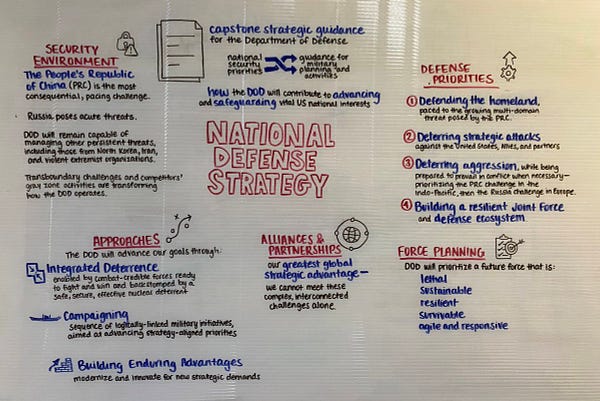
THE UNCLASSIFIED 2022 National Defense Strategy is out and everyone in the national security world has thoughts on it. It’s a good document that rightly places China as the main threat, some say; others think it’s similar to the last one with new buzzwords. And my favorite, from former Pentagon official Kathleen McInnis: “Every four years, the strategic studies community tackles the NDS and its core concepts with the enthusiasm and vigor of kids taking down a piñata at a birthday party.” After that, she dives into the central tenet of the document known as “integrated deterrence,” which boils down to having the entire federal government speak with one voice to deter America’s rivals.
That’s easier said than done, McInnis writes. “That the U.S. government’s right hand should be able to talk to and work with its left hand is obvious. Yet anyone who has worked in an interagency setting knows exactly how hard it can be to get the government to speak with one voice and act towards a common intention.”
China—the main adversary we face in this “decisive decade,” according to the NDS—doesn’t have the same issue. Chinese President Xi Jinping recently secured his long-term hold on power and can issue orders to Communist Party officials through thousands of “red phones” sitting on their desks.
But the era of the Pentagon claiming its freedom of navigation operations near Chinese shores, reconnaissance flights, and multilateral exercises are merely “‘things we have always done’ is over,” says John Culver, a retired CIA officer with extensive expertise in China, previewing what’s likely to come in response from Beijing:
“This will incentivize Chinese responses, especially with U.S. allies and partners in the region, including pointed exercises by the People’s Liberation Army.”
You can view the full National Defense Strategy here or check out the easily digestible whiteboard version by Marine Lt. Kayla Haas:


🚨 The Rundown
Ukraine carried out a “massive” drone attack on Russia’s Black Sea Fleet in Crimea, damaging at least one warship. You can see bullets piercing the waves in this remarkable video filmed from one of the drone boats involved in the attack.
“It had all the thrill of a daring commando raid, filmed live. But Saturday’s dawn raid on Russia’s Black Sea fleet at Sevastopol was not carried out by elite soldiers, but by 16 drones, nine in the air and seven at sea – prompting questions as to whether the attack represented a revolutionary moment in the history of warfare,” wrote The Guardian.
A similar kayak-like craft rigged with a camera and sensors washed ashore in September.
Ukrainian drone pilots say they typically fly over Russian lines and bring their flight and video data home for analysis by artificial intelligence to spot “Russia’s often well-camouflaged equipment.” Interesting.
North Korea fired “as many as 23 missiles” in a day as tensions rise on the Korean peninsula.
New aerial photos of China’s manmade islands in the South China Sea show gun emplacements, radar, close-in weapons systems, and military barracks. More than 5,000 Chinese military officers and soldiers are stationed on such islands, which China has developed through “unprecedented dredging and artificial island-building” since 2013.
In March, Adm. John Aquilino said at least three of China’s nearly 30 island outposts were fully militarized with anti-ship and anti-aircraft missiles, jamming equipment, and fighter jets.
Chinese President Xi Jinping publicly committed to not “militarize” the artificial islands in 2015. The lie detector determined that was a lie.
CFR has good background here on the history behind the construction of islands in a region that sees trillions in global trade pass through and has an estimated 11 billion barrels of untapped oil under the surface.
The Defense Science Board will hold a classified meeting in mid-November to discuss the findings of the 2022 "Summer Study on Technology Superiority.” Announced in July, the objective of the study is to “recommend concepts, capabilities, and strategies that may enhance the military technological advantage” of the United States.
Over 6,000 soldiers are going through a “crucible” of training in Hawaii until Nov. 10 that will “replicate the conditions” they should expect during combat operations in the Indo-Pacific region, says Army Brig. Gen. Jeffrey VanAntwerp.
The Army’s 25th Infantry Division, the new 3rd Marine Littoral Regiment, and troops from Thailand, Indonesia, and the Philippines will partner up to fight two battalions of the Army’s 196th Infantry Brigade, which will be “running and gunning as if they were a Chinese unit,” according to Defense News, “using small drones, jamming, and other means to get inside the heads of their opponents.”
“We will sweat together, bust through gulches together, learn together, fight the enemy together and win together,” said Col. Graham White, commander of the 2nd Infantry Brigade Combat Team.
Daniel Edmund Duggan, 54, was apprehended “pursuant to a request from the United States” and faces extradition but the charges remain unknown. The former Marine Harrier pilot moved to Beijing in 2014 and may have trained Chinese pilots.
Duggan’s arrest comes weeks after the U.K. Ministry of Defense said dozens of U.K. military pilots were lured with large sums of money to train China’s military.
This situation remains murky, but it’s worth noting that Duggan has been out of the military for a while. According to his records, then-Maj. Duggan left the Marine Corps in Sept. 2002 after serving 13 years in uniform.
Kevin Chalker, who spied on Doha’s rivals to help it land the 2022 World Cup, tried to “set up high-level meetings between Qatari officials and top CIA leaders” and pitched a covert influence operation to “damage the reputations of U.S. officials perceived as Qatar’s enemies,” according to an AP investigation.
The oldest prisoner held by the U.S. in Guantanamo Bay has been released to Pakistan. Saifullah Paracha, 75, who was arrested in 2003 and accused of being an al-Qaeda financier, was never charged and was cleared in May as “not a continuing threat.”
The U.S. currently holds 35 prisoners in Gitmo; 20 are eligible for transfer pending diplomatic deals with countries to take them in.
The Air Force is pulling its fleet of permanently stationed F-15 fighters in Okinawa, Japan, and replacing it with a “rotational” force of more advanced jets sent from the States. The U.S. reportedly plans to send fifth-generation F-22 Raptors there for about six months from squadrons in Alaska.
The drawdown of F-15s is set to happen over the next two years. Several Republican lawmakers questioned the move, saying it could send “the wrong signal” at a time when China is becoming more aggressive.
The Marine Corps released a new recruiting commercial focused on “shifting threats.” The one-minute ad begins with Marines carrying out a noncombatant evacuation operation before showing well-equipped grunts seizing an island, countering hostile drones, and using their own drones to target an enemy for a missile strike.
This is a recruiting ad, so its primary goal is to convince an 18-year-old high schooler that they should join the Marine Corps. But it’s also a window into how the service sees itself on the future battlefield, offering a good visual depiction of its “Stand In Forces” concept to keep tabs on China’s navy.
Speaking of China, the U.S. wants to park 6 nuclear-capable B-52 bombers in Australia in a not-so-subtle message to Beijing.
Meanwhile, China has conducted 20 times as many hypersonic missile tests as the United States, according to a new report from the Congressional Research Service (CRS).
The 33-page report with background on the development of such weapons—which fly low to evade radar detection while carrying a nuclear warhead toward a target at Mach 5—notes that the Pentagon requested $4.7 billion for hypersonic research in 2023 but hasn’t yet found a favorite.
The U.S. has several hypersonic prototypes in the pipeline scheduled to conduct further testing in 2023, including the Army’s Long-Range Hypersonic Weapon (LRHW) and the Hypersonic Air-breathing Weapon Concept (HAWC) from the Air Force and DARPA.
The 41-page report offers a helpful primer on the national security implications of AI, lethal drones, hypersonic weapons, and other technologies developed by the United States, China, and Russia.
The good news: we’re working on all kinds of amazing things that will give us the technological edge. The bad news? So is everyone else.
“Many emerging technologies exhibit characteristics that could potentially affect the future character of war,” the report says on page 29 of potential implications for warfighting. “For example, developments in technologies such as AI, big data analytics, and lethal autonomous weapons could diminish or remove the need for a human operator. This could, in turn, increase combat efficiency and accelerate the pace of combat—potentially with destabilizing consequences.”
Always look up: “…swarms of coordinated, unmanned vehicles could overwhelm defensive systems, providing a greater advantage to the attacker, while directed energy weapons that provide a low-cost means of neutralizing such attacks, could favor the defender. Thus, emerging technologies could shift the offense-defense balance multiple times over the coming decades.”
We’re also headed for a world in which drones potentially fly and kill without humans in the loop: “…AI could be paired with quantum computing to produce more powerful methods of machine learning, potentially leading to improvements in image recognition and target identification and enabling more sophisticated autonomous weapons.
Finally, a couple of recent Freedom of Information Act releases caught my eye:
Defense Intelligence Agency (DIA) Responses to Questions for the Record (QFR) 2016-2018
There are many more at Government Attic, a gold mine for thousands of federal documents, emails, and reports released under FOIA. (By the way, I file all of my requests through MuckRock. You can find all the documents I’ve collected here.)
You’re caught up. I’m also super close to hitting 2,500 subscribers, an awesome milestone considering The Ruck is barely two months old. Thank you for reading! I’m so grateful for your support and appreciate you sharing my work with others. And huge thanks as always to the hundreds of paid Ruck Insiders supporting these dispatches.
See you next week! —Paul
Word-of-mouth is the best way you can help me reach new readers. Please use THIS LINK to fire off an easy pre-written email to a friend.
🔥 Let me know what I missed at paulszoldra@protonmail.com (anonymity guaranteed and encrypted when using ProtonMail). I’m also on Twitter at @PaulSzoldra and there’s no way in hell I’m going to pay for it.
My portfolio page has more about me and my past work if you’re curious. Thanks for reading! —Paul
2022 Ruck Insider Dispatches: China’s War Preparation · War In 2030 · Ghosts Of August 26 · Psychological Warfare · Ukraine Drone Videos · Russian Army · Taiwan War · Special Operators ·





The Ruck and The Hunt for Tom Clancy are the best national security newsletters on Substack with zero competition.
Great FOIA stuff today. The Black Vault is another good FOIA resource: https://www.theblackvault.com/documentarchive/